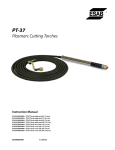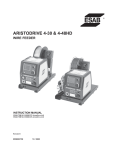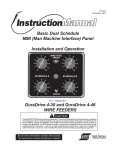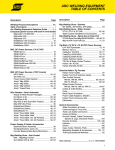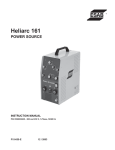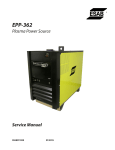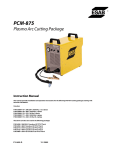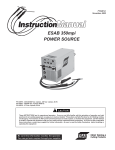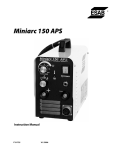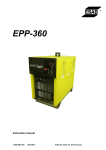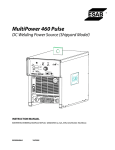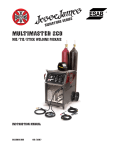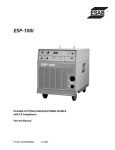Download ESAB MultiPower 460 Pulse Instruction manual
Transcript
DuraDrive 4-30 Wire Feeder Instruction Literature ESAB Item No. 0558001911 - DuraDrive 4-30 F15-635-H 06 / 2008 Be sure this information reaches the operator. You can get extra copies through your supplier. caution These INSTRUCTIONS are for experienced operators. If you are not fully familiar with the principles of operation and safe practices for arc welding and cutting equipment, we urge you to read our booklet, “Precautions and Safe Practices for Arc Welding, Cutting, and Gouging,” Form 52-529. Do NOT permit untrained persons to install, operate, or maintain this equipment. Do NOT attempt to install or operate this equipment until you have read and fully understand these instructions. If you do not fully understand these instructions, contact your supplier for further information. Be sure to read the Safety Precautions before installing or operating this equipment. USER RESPONSIBILITY This equipment will perform in conformity with the description thereof contained in this manual and accompanying labels and/or inserts when installed, operated, maintained and repaired in accordance with the instructions provided. This equipment must be checked periodically. Malfunctioning or poorly maintained equipment should not be used. Parts that are broken, missing, worn, distorted or contaminated should be replaced immediately. Should such repair or replacement become necessary, the manufacturer recommends that a telephone or written request for service advice be made to the Authorized Distributor from whom it was purchased. This equipment or any of its parts should not be altered without the prior written approval of the manufacturer. The user of this equipment shall have the sole responsibility for any malfunction which results from improper use, faulty maintenance, damage, improper repair or alteration by anyone other than the manufacturer or a service facility designated by the manufacturer. READ AND UNDERSTAND THE INSTRUCTION MANUAL BEFORE INSTALLING OR OPERATING. PROTECT YOURSELF AND OTHERS! TABLE OF CONTENTS SECTIONSECTIONPAGE 1 DESCRIPTION ............................................................................................................................................................................17 2 3 4 INSTALLATION ............................................................................................................................................................................25 OPERATION ............................................................................................................................................................................29 MAINTENANCE ............................................................................................................................................................................33 5 TROUBLESHOOTING ............................................................................................................................................................................35 6 REPLACEMENT PARTS........................................................................................................................................................................... 39 TABLE OF CONTENTS 4 safety precautions 1.0Safety Precautions 1.1Safety - English WARNING: These Safety Precautions are for your protection. They summarize precautionary information from the references listed in Additional Safety Information section. Before performing any installation or operating procedures, be sure to read and follow the safety precautions listed below as well as all other manuals, material safety data sheets, labels, etc. Failure to observe Safety Precautions can result in injury or death. FIRES AND EXPLOSIONS -- Heat from flames and arcs can start fires. Hot slag or sparks can also cause fires and explosions. Therefore: 1. Remove all combustible materials well away from the work area or cover the materials with a protective non-flammable covering. Combustible materials include wood, cloth, sawdust, liquid and gas fuels, solvents, paints and coatings, paper, etc. 2. Hot sparks or hot metal can fall through cracks or crevices in floors or wall openings and cause a hidden smoldering fire or fires on the floor below. Make certain that such openings are protected from hot sparks and metal.“ 3. Do not weld, cut or perform other hot work until the workpiece has been completely cleaned so that there are no substances on the workpiece which MIGht produce flammable or toxic vapors. Do not do hot work on closed containers. They may explode. 4. Have fire extinguishing equipment handy for instant use, such as a garden hose, water pail, sand bucket, or portable fire extinguisher. Be sure you are trained in its use. 5. Do not use equipment beyond its ratings. For example, overloaded welding cable can overheat and create a fire hazard. 6. After completing operations, inspect the work area to make certain there are no hot sparks or hot metal which could cause a later fire. Use fire watchers when necessary. 7. For additional information, refer to NFPA Standard 51B, "Fire Prevention in Use of Cutting and Welding Processes", available from the National Fire Protection Association, Batterymarch Park, Quincy, MA 02269. PROTECT YOURSELF AND OTHERS -Some welding, cutting, and gouging processes are noisy and require ear protection. The arc, like the sun, emits ultraviolet (UV) and other radiation and can injure skin and eyes. Hot metal can cause burns. Training in the proper use of the processes and equipment is essential to prevent accidents. Therefore: 1. Always wear safety glasses with side shields in any work area, even if welding helmets, face shields, and goggles are also required. 2. Use a face shield fitted with the correct filter and cover plates to protect your eyes, face, neck, and ears from sparks and rays of the arc when operating or observing operations. Warn bystanders not to watch the arc and not to expose themselves to the rays of the electric-arc or hot metal. 3. Wear flameproof gauntlet type gloves, heavy longsleeve shirt, cuffless trousers, high-topped shoes, and a welding helmet or cap for hair protection, to protect against arc rays and hot sparks or hot metal. A flameproof apron may also be desirable as protection against radiated heat and sparks. 4. Hot sparks or metal can lodge in rolled up sleeves, trouser cuffs, or pockets. Sleeves and collars should be kept buttoned, and open pockets eliminated from the front of clothing. 5. Protect other personnel from arc rays and hot sparks with a suitable non-flammable partition or curtains. 6. Use goggles over safety glasses when chipping slag or grinding. Chipped slag may be hot and can fly far. Bystanders should also wear goggles over safety glasses. ELECTRICAL SHOCK -- Contact with live electrical parts and ground can cause severe injury or death. DO NOT use AC welding current in damp areas, if movement is confined, or if there is danger of falling. 5 safety precautions 1. Be sure the power source frame (chassis) is connected to the ground system of the input power. 3. Welders should use the following procedures to minimize exposure to EMF: A.Route the electrode and work cables together. Secure them with tape when possible. 2. Connect the workpiece to a good electrical ground. B. Never coil the torch or work cable around your body. 3. Connect the work cable to the workpiece. A poor or missing connection can expose you or others to a fatal shock. C.Do not place your body between the torch and work cables. Route cables on the same side of your body. 4. Use well-maintained equipment. Replace worn or damaged cables. 5. Keep everything dry, including clothing, work area, cables, torch/electrode holder, and power source. D.Connect the work cable to the workpiece as close as possible to the area being welded. E. Keep welding power source and cables as far away from your body as possible. 6. Make sure that all parts of your body are insulated from work and from ground. 7. Do not stand directly on metal or the earth while working in tight quarters or a damp area; stand on dry boards or an insulating platform and wear rubber-soled shoes. FUMES AND GASES -- Fumes and gases, can cause discomfort or harm, particularly in confined spaces. Do not breathe fumes and gases. Shielding gases can cause asphyxiation. Therefore: 8. Put on dry, hole-free gloves before turning on the power. 1. Always provide adequate ventilation in the work area by natural or mechanical means. Do not weld, cut, or gouge on materials such as galvanized steel, stainless steel, copper, zinc, lead, beryllium, or cadmium unless positive mechanical ventilation is provided. Do not breathe fumes from these materials. 9. Turn off the power before removing your gloves. 10. Refer to ANSI/ASC Standard Z49.1 (listed on next page) for specific grounding recommendations. Do not mistake the work lead for a ground cable. 2. Do not operate near degreasing and spraying operations. The heat or arc rays can react with chlorinated hydrocarbon vapors to form phosgene, a highly toxic gas, and other irritant gases. ELECTRIC AND MAGNETIC FIELDS — May be dangerous. Electric current flowing through any conductor causes localized Electric and Magnetic Fields (EMF). Welding and cutting current creates EMF around welding cables and welding machines. Therefore: 3. If you develop momentary eye, nose, or throat irritation while operating, this is an indication that ventilation is not adequate. Stop work and take necessary steps to improve ventilation in the work area. Do not continue to operate if physical discomfort persists. 1. Welders having pacemakers should consult their physician before welding. EMF may interfere with some pacemakers. 4. Refer to ANSI/ASC Standard Z49.1 (see listing below) for specific ventilation recommendations. 2. Exposure to EMF may have other health effects which are unknown. 6 safety precautions 5.WARNING:This product, when used for welding or cutting, produces fumes or gases which contain chemicals known to the State of California to cause birth defects and, in some cases, cancer. (California Health & Safety Code §25249.5 et seq.) 1. Always have qualified personnel perform the installation, troubleshooting, and maintenance work. Do not perform any electrical work unless you are qualified to perform such work. 2. Before performing any maintenance work inside a power source, disconnect the power source from the incoming electrical power. 3. Maintain cables, grounding wire, connections, power cord, and power supply in safe working order. Do not operate any equipment in faulty condition. CYLINDER HANDLING -- Cylinders, if mishandled, can rupture and violently release gas. Sudden rupture of cylinder, valve, or relief device can injure or kill. Therefore: 4. Do not abuse any equipment or accessories. Keep equipment away from heat sources such as furnaces, wet conditions such as water puddles, oil or grease, corrosive atmospheres and inclement weather. 1. Use the proper gas for the process and use the proper pressure reducing regulator designed to operate from the compressed gas cylinder. Do not use adaptors. Maintain hoses and fittings in good condition. Follow manufacturer's operating instructions for mounting regulator to a compressed gas cylinder. 5. Keep all safety devices and cabinet covers in position and in good repair. 6. Use equipment only for its intended purpose. Do not modify it in any manner. 2. Always secure cylinders in an upright position by chain or strap to suitable hand trucks, undercarriages, benches, walls, post, or racks. Never secure cylinders to work tables or fixtures where they may become part of an electrical circuit. ADDITIONAL SAFETY INFORMATION -- For more information on safe practices for electric arc welding and cutting equipment, ask your supplier for a copy of "Precautions and Safe Practices for Arc Welding, Cutting and Gouging", Form 52-529. 3. When not in use, keep cylinder valves closed. Have valve protection cap in place if regulator is not connected. Secure and move cylinders by using suitable hand trucks. Avoid rough handling of cylinders. 4. Locate cylinders away from heat, sparks, and flames. Never strike an arc on a cylinder. The following publications, which are available from the American Welding Society, 550 N.W. LeJuene Road, Miami, FL 33126, are recommended to you: 5. For additional information, refer to CGA Standard P-1, "Precautions for Safe Handling of Compressed Gases in Cylinders", which is available from Compressed Gas Association, 1235 Jefferson Davis Highway, Arlington, VA 22202. 1. ANSI/ASC Z49.1 - "Safety in Welding and Cutting" 2. AWS C5.1 - "Recommended Practices for Plasma Arc Welding" 3. AWS C5.2 - "Recommended Practices for Plasma Arc Cutting" EQUIPMENT MAINTENANCE -- Faulty or improperly maintained equipment can cause injury or death. Therefore: 4. AWS C5.3 - "Recommended Practices for Air Carbon Arc Gouging and Cutting" 7 safety precautions 5. AWS C5.5 - "Recommended Practices for Gas Tungsten Arc Welding“ 6. AWS C5.6 - "Recommended Practices for Gas Metal Arc Welding"“ 7. AWS SP - "Safe Practices" - Reprint, Welding Handbook. 8. ANSI/AWS F4.1, "Recommended Safe Practices for Welding and Cutting of Containers That Have Held Hazardous Substances." Meaning of symbols - As used throughout this manual: Means Attention! Be Alert! Your safety is involved. Means immediate hazards which, if not avoided, will result in immediate, serious personal injury or loss of life. Means potential hazards which could result in personal injury or loss of life. Means hazards which could result in minor personal injury. 8 sEGURIDAD La escoria puede estar caliente y desprenderse con velocidad. Personas cercanas deberán usar gafas de seguridad y careta protectora. 1.2Safety - Spanish ADVERTENCIA: Estas Precauciones de Seguridad son para su protección. Ellas hacen resumen de información proveniente de las referencias listadas en la sección "Información Adicional Sobre La Seguridad". Antes de hacer cualquier instalación o procedimiento de operación , asegúrese de leer y seguir las precauciones de seguridad listadas a continuación así como también todo manual, hoja de datos de seguridad del material, calcomanias, etc. El no observar las Precauciones de Seguridad puede resultar en daño a la persona o muerte. FUEGO Y EXPLOSIONES -- El calor de las flamas y el arco pueden ocacionar fuegos. Escoria caliente y las chispas pueden causar fuegos y explosiones. Por lo tanto: 1. Remueva todo material combustible lejos del área de trabajo o cubra los materiales con una cobija a prueba de fuego. Materiales combustibles incluyen madera, ropa, líquidos y gases flamables, solventes, pinturas, papel, etc. 2. Chispas y partículas de metal pueden introducirse en las grietas y agujeros de pisos y paredes causando fuegos escondidos en otros niveles o espacios. Asegúrese de que toda grieta y agujero esté cubierto para proteger lugares adyacentes contra fuegos. 3. No corte, suelde o haga cualquier otro trabajo relacionado hasta que la pieza de trabajo esté totalmente limpia y libre de substancias que puedan producir gases inflamables o vapores tóxicos. No trabaje dentro o fuera de contenedores o tanques cerrados. Estos pueden explotar si contienen vapores inflamables. 4. Tenga siempre a la mano equipo extintor de fuego para uso instantáneo, como por ejemplo una manguera con agua, cubeta con agua, cubeta con arena, o extintor portátil. Asegúrese que usted esta entrenado para su uso. 5. No use el equipo fuera de su rango de operación. Por ejemplo, el calor causado por cable sobrecarga en los cables de soldar pueden ocasionar un fuego. 6. Después de termirar la operación del equipo, inspeccione el área de trabajo para cerciorarse de que las chispas o metal caliente ocasionen un fuego más tarde. Tenga personal asignado para vigilar si es necesario. 7. Para información adicional , haga referencia a la publicación NFPA Standard 51B, "Fire Prevention in Use of Cutting and Welding Processes", disponible a través de la National Fire Protection Association, Batterymarch Park, Quincy, MA 02269. PROTEJASE USTED Y A LOS DEMAS-Algunos procesos de soldadura, corte y ranurado son ruidosos y requiren protección para los oídos. El arco, como el sol , emite rayos ultravioleta (UV) y otras radiaciones que pueden dañar la piel y los ojos. El metal caliente causa quemaduras. EL entrenamiento en el uso propio de los equipos y sus procesos es esencial para prevenir accidentes. Por lo tanto: 1. Utilice gafas de seguridad con protección a los lados siempre que esté en el área de trabajo, aún cuando esté usando careta de soldar, protector para su cara u otro tipo de protección. 2. Use una careta que tenga el filtro correcto y lente para proteger sus ojos, cara, cuello, y oídos de las chispas y rayos del arco cuando se esté operando y observando las operaciones. Alerte a todas las personas cercanas de no mirar el arco y no exponerse a los rayos del arco eléctrico o el metal fundido. 3. Use guantes de cuero a prueba de fuego, camisa pesada de mangas largas, pantalón de ruedo liso, zapato alto al tobillo, y careta de soldar con capucha para el pelo, para proteger el cuerpo de los rayos y chispas calientes provenientes del metal fundido. En ocaciones un delantal a prueba de fuego es necesario para protegerse del calor radiado y las chispas. 4. Chispas y partículas de metal caliente puede alojarse en las mangas enrolladas de la camisa , el ruedo del pantalón o los bolsillos. Mangas y cuellos deberán mantenerse abotonados, bolsillos al frente de la camisa deberán ser cerrados o eliminados. 5. Proteja a otras personas de los rayos del arco y chispas calientes con una cortina adecuada noflamable como división. 6. Use careta protectora además de sus gafas de seguridad cuando esté removiendo escoria o puliendo. CHOQUE ELECTRICO -- El contacto con las partes eléctricas energizadas y tierra puede causar daño severo o muerte. NO use soldadura de corriente alterna (AC) en áreas húmedas, de movimiento confinado en lugares estrechos o si hay posibilidad de caer al suelo. 9 sEGURIDAD 3.Los soldadores deberán usar los siguientes procedimientos para minimizar exponerse al EMF: 1. Asegúrese de que el chasis de la fuente de poder esté conectado a tierra através del sistema de electricidad primario. 2. Conecte la pieza de trabajo a un buen sistema de tierra física. 3. Conecte el cable de retorno a la pieza de trabajo. Cables y conductores expuestos o con malas conexiones pueden exponer al operador u otras personas a un choque eléctrico fatal. 4. Use el equipo solamente si está en buenas condiciones. Reemplaze cables rotos, dañados o con conductores expuestos. 5. Mantenga todo seco, incluyendo su ropa, el área de trabajo, los cables, antorchas, pinza del electrodo, y la fuente de poder. 6. Asegúrese que todas las partes de su cuerpo están insuladas de ambos, la pieza de trabajo y tierra. 7. No se pare directamente sobre metal o tierra mientras trabaja en lugares estrechos o áreas húmedas; trabaje sobre un pedazo de madera seco o una plataforma insulada y use zapatos con suela de goma. 8. Use guantes secos y sin agujeros antes de energizar el equipo. 9. Apage el equipo antes de quitarse sus guantes. 10. Use como referencia la publicación ANSI/ASC Standard Z49.1 (listado en la próxima página) para recomendaciones específicas de como conectar el equipo a tierra. No confunda el cable de soldar a la pieza de trabajo con el cable a tierra. A.Mantenga el electrodo y el cable a la pieza de trabajo juntos, hasta llegar a la pieza que usted quiere soldar. Asegúrelos uno junto al otro con cinta adhesiva cuando sea posible. B. Nunca envuelva los cables de soldar alrededor de su cuerpo. C.Nunca ubique su cuerpo entre la antorcha y el cable, a la pieza de trabajo. Mantega los cables a un sólo lado de su cuerpo. D.Conecte el cable de trabajo a la pieza de trabajo lo más cercano posible al área de la soldadura. E. Mantenga la fuente de poder y los cables de soldar lo más lejos posible de su cuerpo. HUMO Y GASES -- El humo y los gases, pueden causar malestar o daño, particularmente en espacios sin ventilación. No inhale el humo o gases. El gas de protección puede causar falta de oxígeno. Por lo tanto: 1. Siempre provea ventilación adecuada en el área de trabajo por medio natural o mecánico. No solde, corte, o ranure materiales con hierro galvanizado, acero inoxidable, cobre, zinc, plomo, berílio, o cadmio a menos que provea ventilación mecánica positiva . No respire los gases producidos por estos materiales. 2. No opere cerca de lugares donde se aplique substancias químicas en aerosol. El calor de los rayos del arco pueden reaccionar con los vapores de hidrocarburo clorinado para formar un fosfógeno, o gas tóxico, y otros irritant es. 3. Si momentáneamente desarrolla inrritación de ojos, nariz o garganta mientras est á operando, es indicación de que la ventilación no es apropiada. Pare de trabajar y tome las medidas necesarias para mejorar la ventilación en el área de trabajo. No continúe operando si el malestar físico persiste. 4. Haga referencia a la publicación ANSI/ASC Standard Z49.1 (Vea la lista a continuación) para recomendaciones específicas en la ventilación. CAMPOS ELECTRICOS Y MAGNETICOS - Son peligrosos. La corriente eléctrica fluye através de cualquier conductor causando a nivel local Campos Eléctricos y Magnéticos (EMF). Las corrientes en el área de corte y soldadura, crean EMF alrrededor de los cables de soldar y las maquinas. Por lo tanto: 1. Soldadores u Operadores que use marca-pasos para el corazón deberán consultar a su médico antes de soldar. El Campo Electromagnético (EMF) puede interferir con algunos marca-pasos. 2.Exponerse a campos electromagnéticos (EMF) puede causar otros efectos de salud aún desconocidos. 10 sEGURIDAD 5.ADVERTENCIA-- Este producto cuando se utiliza para soldaduras o cortes, produce humos o gases, los cuales contienen químicos conocidos por el Estado de California de causar defectos en el nacimiento, o en algunos casos, Cancer. (California Health & Safety Code §25249.5 et seq.) 1. Siempre tenga personal cualificado para efectuar l a instalación, diagnóstico, y mantenimiento del equipo. No ejecute ningún trabajo eléctrico a menos que usted esté cualificado para hacer el trabajo. 2. Antes de dar mantenimiento en el interior de la fuente de poder, desconecte la fuente de poder del suministro de electricidad primaria. 3. Mantenga los cables, cable a tierra, conexciones, cable primario, y cualquier otra fuente de poder en buen estado operacional. No opere ningún equipo en malas condiciones. 4. No abuse del equipo y sus accesorios. Mantenga el equipo lejos de cosas que generen calor como hornos, también lugares húmedos como charcos de agua , aceite o grasa, atmósferas corrosivas y las inclemencias del tiempo. 5. Mantenga todos los artículos de seguridad y coverturas del equipo en su posición y en buenas condiciones. 6. Use el equipo sólo para el propósito que fue diseñado. No modifique el equipo en ninguna manera. MANEJO DE CILINDROS-- Los cilindros, si no son manejados correctamente, pueden romperse y liberar violentamente gases. Rotura repentina del cilindro, válvula, o válvula de escape puede causar daño o muerte. Por lo tanto: 1. Utilize el gas apropiado para el proceso y utilize un regulador diseñado para operar y reducir la presión del cilindro de gas . No utilice adaptadores. Mantenga las mangueras y las conexiones en buenas condiciones. Observe las instrucciones de operación del manufacturero para montar el regulador en el cilindro de gas comprimido. INFORMACION ADICIONAL DE SEGURIDAD -- Para más información sobre las prácticas de seguridad de los equipos de arco eléctrico para soldar y cortar, pregunte a su suplidor por una copia de "Precautions and Safe Practices for Arc Welding, Cutting and Gouging-Form 52-529. 2. Asegure siempre los cilindros en posición vertical y amárrelos con una correa o cadena adecuada para asegurar el cilindro al carro, transportes, tablilleros, paredes, postes, o armazón. Nunca asegure los cilindros a la mesa de trabajo o las piezas que son parte del circuito de soldadura . Este puede ser parte del circuito elélectrico. Las siguientes publicaciones, disponibles através de la American Welding Society, 550 N.W. LeJuene Road, Miami, FL 33126, son recomendadas para usted: 3. Cuando el cilindro no está en uso, mantenga la válvula del cilindro cerrada. Ponga el capote de protección sobre la válvula si el regulador no está conectado. Asegure y mueva los cilindros utilizando un carro o transporte adecuado. Evite el manejo brusco de los 1. ANSI/ASC Z49.1 - "Safety in Welding and Cutting" 2. AWS C5.1 - "Recommended Practices for Plasma Arc Welding" MANTENIMIENTO DEL EQUIPO -- Equipo defectuoso o mal mantenido puede causar daño o muerte. Por lo tanto: 3. AWS C5.2 - "Recommended Practices for Plasma Arc Cutting" 4. AWS C5.3 - "Recommended Practices for Air Carbon Arc Gouging and Cutting" 11 sEGURIDAD SIGNIFICADO DE LOS sImbolOs -- Según usted avanza en la lectura de este folleto: Los Símbolos Significan ¡Atención! ¡Esté Alerta! Se trata de su seguridad. Significa riesgo inmediato que, de no ser evadido, puede resultar inmediatamente en serio daño personal o la muerte. Significa el riesgo de un peligro potencial que puede resultar en serio daño personal o la muerte. Significa el posible riesgo que puede resultar en menores daños a la persona. 12 sÉCURITÉ 1.3Safety - French INCENDIES ET EXPLOSIONS -- La chaleur provenant des flammes ou de l'arc peut provoquer un incendie. Le laitier incandescent ou les étincelles peuvent également provoquer un incendie ou une explosion. Par conséquent : AVERTISSEMENT : Ces règles de sécurité ont pour but d'assurer votre protection. Ils récapitulent les informations de précaution provenant des références dans la section des Informations de sécurité supplémentaires. Avant de procéder à l'installation ou d'utiliser l'unité, assurez-vous de lire et de suivre les précautions de sécurité ci-dessous, dans les manuels, les fiches d'information sur la sécurité du matériel et sur les étiquettes, etc. Tout défaut d'observer ces précautions de sécurité peut entraîner des blessures graves ou mortelles. 1. Éloignez suffisamment tous les matériaux combustibles de l'aire de travail et recouvrez les matériaux avec un revêtement protecteur ininflammable. Les matériaux combustibles incluent le bois, les vêtements, la sciure, le gaz et les liquides combustibles, les solvants, les peintures et les revêtements, le papier, etc. 2. Les étincelles et les projections de métal incandescent peuvent tomber dans les fissures dans les planchers ou dans les ouvertures des murs et déclencher un incendie couvant à l'étage inférieur Assurez-vous que ces ouvertures sont bien protégées des étincelles et du métal incandescent. 3. N'exécutez pas de soudure, de coupe ou autre travail à chaud avant d'avoir complètement nettoyé la surface de la pièce à traiter de façon à ce qu'il n'ait aucune substance présente qui pourrait produire des vapeurs inflammables ou toxiques. N'exécutez pas de travail à chaud sur des contenants fermés car ces derniers pourraient exploser. 4. Assurez-vous qu'un équipement d'extinction d'incendie est disponible et prêt à servir, tel qu'un tuyau d'arrosage, un seau d'eau, un seau de sable ou un extincteur portatif. Assurez-vous d'être bien instruit par rapport à l'usage de cet équipement. 5. Assurez-vous de ne pas excéder la capacité de l'équipement. Par exemple, un câble de soudage surchargé peut surchauffer et provoquer un incendie. 6. Une fois les opérations terminées, inspectez l'aire de travail pour assurer qu'aucune étincelle ou projection de métal incandescent ne risque de provoquer un incendie ultérieurement. Employez des guetteurs d'incendie au besoin. 7. Pour obtenir des informations supplémentaires, consultez le NFPA Standard 51B, "Fire Prevention in Use of Cutting and Welding Processes", disponible au National Fire Protection Association, Batterymarch Park, Quincy, MA 02269. PROTÉGEZ-VOUS -- Les processus de soudage, de coupage et de gougeage produisent un niveau de bruit élevé et exige l'emploi d'une protection auditive. L'arc, tout comme le soleil, émet des rayons ultraviolets en plus d'autre rayons qui peuvent causer des blessures à la peau et les yeux. Le métal incandescent peut causer des brûlures. Une formation reliée à l'usage des processus et de l'équipement est essentielle pour prévenir les accidents. Par conséquent: 1. Portez des lunettes protectrices munies d'écrans latéraux lorsque vous êtes dans l'aire de travail, même si vous devez porter un casque de soudeur, un écran facial ou des lunettes étanches. 2. Portez un écran facial muni de verres filtrants et de plaques protectrices appropriées afin de protéger vos yeux, votre visage, votre cou et vos oreilles des étincelles et des rayons de l'arc lors d'une opération ou lorsque vous observez une opération. Avertissez les personnes se trouvant à proximité de ne pas regarder l'arc et de ne pas s'exposer aux rayons de l'arc électrique ou le métal incandescent. 3. Portez des gants ignifugiés à crispin, une chemise épaisse à manches longues, des pantalons sans rebord et des chaussures montantes afin de vous protéger des rayons de l'arc, des étincelles et du métal incandescent, en plus d'un casque de soudeur ou casquette pour protéger vos cheveux. Il est également recommandé de porter un tablier ininflammable afin de vous protéger des étincelles et de la chaleur par rayonnement. 4. Les étincelles et les projections de métal incandescent risquent de se loger dans les manches retroussées, les rebords de pantalons ou les poches. Il est recommandé de garder boutonnés le col et les manches et de porter des vêtements sans poches en avant. 5. Protégez toute personne se trouvant à proximité des étincelles et des rayons de l'arc à l'aide d'un rideau ou d'une cloison ininflammable. 6. Portez des lunettes étanches par dessus vos lunettes de sécurité lors des opérations d'écaillage ou de meulage du laitier. Les écailles de laitier incandescent peuvent être projetées à des distances considérables. Les personnes se trouvant à proximité doivent également porter des lunettes étanches par dessus leur lunettes de sécurité. CHOC ÉLECTRIQUE -- Le contact avec des pièces électriques ou les pièces de mise à la terre sous tension peut causer des blessures graves ou mortelles. NE PAS utiliser un courant de soudage c.a. dans un endroit humide, en espace restreint ou si un danger de chute se pose. 13 sÉCURITÉ 1. Assurez-vous que le châssis de la source d'alimentation est branché au système de mise à la terre de l'alimentation d'entrée. 2. Branchez la pièce à traiter à une bonne mise de terre électrique. 3. Branchez le câble de masse à la pièce à traiter et assurez une bonne connexion afin d'éviter le risque de choc électrique mortel. 4. Utilisez toujours un équipement correctement entretenu. Remplacez les câbles usés ou endommagés. 5. Veillez à garder votre environnement sec, incluant les vêtements, l'aire de travail, les câbles, le porteélectrode/torche et la source d'alimentation. 6. Assurez-vous que tout votre corps est bien isolé de la pièce à traiter et des pièces de la mise à la terre. 7. Si vous devez effectuer votre travail dans un espace restreint ou humide, ne tenez vous pas directement sur le métal ou sur la terre; tenezvous sur des planches sèches ou une plate-forme isolée et portez des chaussures à semelles de caoutchouc. 8. Avant de mettre l'équipement sous tension, isolez vos mains avec des gants secs et sans trous. 9. Mettez l'équipement hors tension avant d'enlever vos gants. 10. Consultez ANSI/ASC Standard Z49.1 (listé à la page suivante) pour des recommandations spécifiques concernant les procédures de mise à la terre. Ne pas confondre le câble de masse avec le câble de mise à la terre. 3. Les soudeurs doivent suivre les procédures suivantes pour minimiser l'exposition aux champs électriques et magnétiques : A.Acheminez l'électrode et les câbles de masse ensemble. Fixez-les à l'aide d'une bande adhésive lorsque possible. B. Ne jamais enrouler la torche ou le câble de masse autour de votre corps. C.Ne jamais vous placer entre la torche et les câbles de masse. Acheminez tous les câbles sur le même côté de votre corps. D.Branchez le câble de masse à la pièce à traiter le plus près possible de la section à souder. E. Veillez à garder la source d'alimentation pour le soudage et les câbles à une distance appropriée de votre corps. LES VAPEURS ET LES GAZ -- peuvent causer un malaise ou des dommages corporels, plus particulièrement dans les espaces restreints. Ne respirez pas les vapeurs et les gaz. Le gaz de protection risque de causer l'asphyxie. Par conséquent : 1. Assurez en permanence une ventilation adéquate dans l'aire de travail en maintenant une ventilation naturelle ou à l'aide de moyens mécanique. N'effectuez jamais de travaux de soudage, de coupage ou de gougeage sur des matériaux tels que l'acier galvanisé, l'acier inoxydable, le cuivre, le zinc, le plomb, le berylliym ou le cadmium en l'absence de moyens mécaniques de ventilation efficaces. Ne respirez pas les vapeurs de ces matériaux. 2. N'effectuez jamais de travaux à proximité d'une opération de dégraissage ou de pulvérisation. Lorsque la chaleur ou le rayonnement de l'arc entre en contact avec les vapeurs d'hydrocarbure chloré, ceci peut déclencher la formation de phosgène ou d'autres gaz irritants, tous extrêmement toxiques. 3. Une irritation momentanée des yeux, du nez ou de la gorge au cours d'une opération indique que la ventilation n'est pas adéquate. Cessez votre travail afin de prendre les mesures nécessaires pour améliorer la ventilation dans l'aire de travail. Ne poursuivez pas l'opération si le malaise persiste. 4. Consultez ANSI/ASC Standard Z49.1 (à la page suivante) pour des recommandations spécifiques concernant la ventilation. CHAMPS ÉLECTRIQUES ET MAGNÉTIQUES — comportent un risque de danger. Le courant électrique qui passe dans n'importe quel conducteur produit des champs électriques et magnétiques localisés. Le soudage et le courant de coupage créent des champs électriques et magnétiques autour des câbles de soudage et l'équipement. Par conséquent : 1. Un soudeur ayant un stimulateur cardiaque doit consulter son médecin avant d'entreprendre une opération de soudage. Les champs électriques et magnétiques peuvent causer des ennuis pour certains stimulateurs cardiaques. 2. L'exposition à des champs électriques et magnétiques peut avoir des effets néfastes inconnus pour la santé. 14 sÉCURITÉ ENTRETIEN DE L'ÉQUIPEMENT -- Un équipement entretenu de façon défectueuse ou inadéquate peut causer des blessures graves ou mortelles. Par conséquent : 1. Efforcez-vous de toujours confier les tâches d'installation, de dépannage et d'entretien à un personnel qualifié. N'effectuez aucune réparation électrique à moins d'être qualifié à cet effet. 2. Avant de procéder à une tâche d'entretien à l'intérieur de la source d'alimentation, débranchez l'alimentation électrique. 3. Maintenez les câbles, les fils de mise à la terre, les branchements, le cordon d'alimentation et la source d'alimentation en bon état. N'utilisez jamais un équipement s'il présente une défectuosité quelconque. 4. N'utilisez pas l'équipement de façon abusive. Gardez l'équipement à l'écart de toute source de chaleur, notamment des fours, de l'humidité, des flaques d'eau, de l'huile ou de la graisse, des atmosphères corrosives et des intempéries. 5. Laissez en place tous les dispositifs de sécurité et tous les panneaux de la console et maintenez-les en bon état. 6. Utilisez l'équipement conformément à son usage prévu et n'effectuez aucune modification. 5.AVERTISSEMENT : Ce produit, lorsqu'il est utilisé dans une opération de soudage ou de coupage, dégage des vapeurs ou des gaz contenant des chimiques considéres par l'état de la Californie comme étant une cause des malformations congénitales et dans certains cas, du cancer. (California Health & Safety Code §25249.5 et seq.) MANIPULATION DES CYLINDRES -La manipulation d'un cylindre, sans observer les précautions nécessaires, peut produire des fissures et un échappement dangereux des gaz. Une brisure soudaine du cylindre, de la soupape ou du dispositif de surpression peut causer des blessures graves ou mortelles. Par conséquent : 1. Utilisez toujours le gaz prévu pour une opération et le détendeur approprié conçu pour utilisation sur les cylindres de gaz comprimé. N'utilisez jamais d'adaptateur. Maintenez en bon état les tuyaux et les raccords. Observez les instructions d'opération du fabricant pour assembler le détendeur sur un cylindre de gaz comprimé. 2. Fixez les cylindres dans une position verticale, à l'aide d'une chaîne ou une sangle, sur un chariot manuel, un châssis de roulement, un banc, un mur, une colonne ou un support convenable. Ne fixez jamais un cylindre à un poste de travail ou toute autre dispositif faisant partie d'un circuit électrique. 3. Lorsque les cylindres ne servent pas, gardez les soupapes fermées. Si le détendeur n'est pas branché, assurez-vous que le bouchon de protection de la soupape est bien en place. Fixez et déplacez les cylindres à l'aide d'un chariot manuel approprié. Toujours manipuler les cylindres avec soin. 4. Placez les cylindres à une distance appropriée de toute source de chaleur, des étincelles et des flammes. Ne jamais amorcer l'arc sur un cylindre. 5. Pour de l'information supplémentaire, consultez CGA Standard P-1, "Precautions for Safe Handling of Compressed Gases in Cylinders", mis à votre disposition par le Compressed Gas Association, 1235 Jefferson Davis Highway, Arlington, VA 22202. INFORMATIONS SUPPLÉMENTAIRES RELATIVES À LA SÉCURITÉ -- Pour obtenir de l'information supplémentaire sur les règles de sécurité à observer pour l'équipement de soudage à l'arc électrique et le coupage, demandez un exemplaire du livret "Precautions and Safe Practices for Arc Welding, Cutting and Gouging", Form 52-529. Les publications suivantes sont également recommandées et mises à votre disposition par l'American Welding Society, 550 N.W. LeJuene Road, Miami, FL 33126 : 1. ANSI/ASC Z49.1 - "Safety in Welding and Cutting" 2. AWS C5.1 - "Recommended Practices for Plasma Arc Welding" 3. AWS C5.2 - "Recommended Practices for Plasma Arc Cutting" 4. AWS C5.3 - "Recommended Practices for Air Carbon Arc Gouging and Cutting" 15 sÉCURITÉ SIGNIFICATION DES SYMBOLES Ce symbole, utilisé partout dans ce manuel, signifie "Attention" ! Soyez vigilant ! Votre sécurité est en jeu. DANGER Signifie un danger immédiat. La situation peut entraîner des blessures graves ou mortelles. AVERTISSEMENT Signifie un danger potentiel qui peut entraîner des blessures graves ou mortelles. ATTENTION Signifie un danger qui peut entraîner des blessures corporelles mineures. 16 SECTION 1 DESCRIPTION 1.0 SAFETY REFERENCES Before the DuraDrive 4-30 wire feeder is put into operation, the safety section at the front of this manual should be read completely. This will help avoid possible injury due to misuse or improper installation. 1.1 DESCRIPTION AND SPECIFICATIONS The DuraDrive 4-30 is a 4 roll drive 42 vac wire feeder with the ability to meet immediate and long term welding requirements of any weld shop. It's "Modular Design" technology permits simplicity and flexibility without unnecessary configuration and installation complexity. The DuraDrive control panels (MMI or Man/Machine Interface) can be easily replaced (plug and play) with optional panels having more functionality and features. The DuraDrive 4-30 wire feeder will handle most welding applications using short arc, spray and pulsed spray arc MIG (GMAW, GMAW-P & MCAW) welding or cored wire (FCAW ) welding with a variety of welding power sources. A. • • • • • • • • • • FEATURES: Modular MMI (Man/Machine Interface) panels for easy function and feature upgradability Heavy duty compact wire feed motor Quick release 4-roll drive assembly; no readjustment of pressure required when rethreading wire. Quick release “No Tools” feed roll system Driven upper and lower drive rolls for positive feed force and maximum wire grip. All control circuits incorporated on one solid‑state printed circuit board, mounted for easy access and removal. Gas purge switch for shield gas flowrate preset. Slow run-in switch sets the wire feed speed at 1/2 the preset until the arc is struck for smoother arc starting. Jog switch for wire inching without energizing power source contactor. Anti‑stick wire burnback control for precise adjustment of amount of wire burnback after wire feed stops, to eliminate freezing of wire in weld pool. • Low voltage circuit (12v) for gun trigger switch, to assure operator safety. • NAS (#4 Tweco) gun adapter • All cable and hose connections are quickly detachable. B. SPECIFICATIONS Input Power Required . .............................................................42 volts, 60 hz, Single Phase Wire Feed Range: Low Range - 50 to 700 in/min (1.2‑18 m/min) High Range - 350 to 999 in/min (9-25 m/min) Wire Sizes : Hard (V-Groove). . . . .............................................................. . 023 thru 1/16‑in.(.6 - 1.6 mm) Tubular (Knurled)....................................................................... 035 thru 5/64‑in.(.9 - 2.0mm) Soft (U-Groove). . . .................................................................. .030 thru 1/16‑in.(.8 - 1.6 mm) Dimensions: Length .................................................................................................................22.5‑in. (572 mm) Width ...................................................................................................................10.5‑in. (268 mm) Height . .................................................................................................................16.5‑in (419 mm) Weight (less wire & cables) ................................................................................46‑lbs. (21 kg). 17 SECTION 1 DESCRIPTION C. Modular MMI (Man/Machine Interface) Panel System Introduction The interchangeable control panels (MMI) are available in 4 different models depending on the needs of the welding operator and the welding application. The panels are designed for easily removal and replacement. The following describes the functions and capability of each MMI panel. Basic MMI Panel The Basic MMI panel is the simplest design with one CV welding schedule having a wire feed speed adjustment and remote voltage adjustment (if the power source is capable of remote voltage control). Basic Dual Schedule MMI Panel The Basic Dual Schedule MMI panel allows the preset of two sets of welding parameters. Both wire feed speed IPM or VOLTS can be preset on power sources with remote voltage capability. The SCHEDULE select switch determines the welding schedule (A or B) to be used when the gun trigger is depressed. The welding schedules (parameters) can be switched while welding using the "Click Click" trigger technique where the gun trigger is released and depressed quickly (within 0.2 sec). This option module can be used to provide a hot start, crater fill or a gap filling welding parameter in addition to the standard welding parameter typically used for the given weld application. NOTE For ALL dual schedule MMI panels, a weld schedule can be disabled by placing the wire feed speed knob to the minimum position or "0" (zero) position. This will eliminate the accidental triggering of the Mig gun into the alternate weld schedule. 18 SECTION 1 DESCRIPTION NOTE Either the 4-in-1 Option Module or the Pulse Selection Option Module can be installed NOT BOTH Digital Dual Schedule MMI Panel The Digital Dual Schedule MMI panel has all the capability of the Basic Dual Schedule panel with the addition of a digital WFS and VOLT meter. The digital WFS meters adds digital presettability to the wire feed speed. The digital wire feed speed can be preset to the IPM (inches per minute) setting desired and the control circuitry will maintain that wire feed speed within +/- 2 ipm. A preset display of the arc voltage is NOT supported. During welding, the average WFS and VOLTS is calculated and the display updated 3 times a second. The last reading is then held for 10 seconds after welding has completed for weld parameter verification and recording. Digital Dual Schedule Pulse MMI Panel The Digital Dual Schedule Pulse MMI panel adds Pulse MIG welding capability and is the most advanced MMI panel for the DuraDrive feeder line. Two welding parameters can be preset on the panel in either the standard (CV) or pulse MIG process mode. The arc starting schedule is selected with the SCHEDULE select switch (A or B). The "Click Click" gun trigger schedule switching technique can be used to change welding parameters while welding. This MMI panel MUST be used with a PULSE SELECTION module installed on the wire feeder control cabinet rear panel. This module can be used with the ESAB 350MPi, MTS-3500i, SVI-450i and MultiPower 460 (non-pulse version) power sources for MIG pulse welding. The DuraDrive feeder is factory shipped configured for the ESAB 350MPi, MTS-3500i and MultiPower 460 power sources. MMI installation and setup instructions for the SVI-450i power source configuration are included in the Dual Pulse MMI installation instructions F15-703. Other ESAB power sources and competitors power sources will not operate in the pulse mode using this Pulse MMI panel. NOTE Power sources with pulsing capability built into the power source (such as the MultiPower 460 Pulse) can utilize any of the MMI panels for pulse operation and does NOT require the Digital Dual; Schedule Pulse MMI panel. 19 SECTION 1 DESCRIPTION NOTE A continuous water supply or re-circulator is required when using a water cooled MIG gun. D. Front Panel Components 1. Modular MMI panel 2. Power On/Off Switch Controls the 42 vac power from the power source. 3. Wire Jog Switch Used to safely thread the wire through the gun liner without applying welding power to the wire or gun assembly. 4. Gas Purge Switch Used to preset the shield gas flowrate without applying welding power to the wire or gun assembly. 5. Gun Trigger Switch Receptacle A two prong “twist to lock” receptacle used to connect the MIG gun trigger circuit to the wire feeder. 6. NAS (#4 Tweco) Power Pin MIG gun connection E. Rear Panel: 1. Burnback (AntiStick) Adjustment The control knob adjusts the time between the wire feed motor brake is applied and the welding contactor is turned “off”. This determines how far the wire will burnback towards the contact tip after welding is completed. If the wire is sticking in the weld pool, turn the knob clockwise a small amount and retest. Continue this procedure until the wire cleans the top of the weld pool or burns back the desired amount. 2. Slow Run-in On/Off When this switch is in the “On” position the wire speed will feed at 1/2 the preset wire feed speed until the arc is struck. The arc detect circuit will then automatically switch to the preset wire feed speed. 3. Option Module Panel Permits the mounting of an optional control modules that add functionality to the DuraDrive wire feeder. 4. Control Cable Receptacle Receptacle that accepts the 19 pin control interconnect cable between the wire feeder and power source. 5. Shield Gas Connection Connect the shielding gas hose from the regulator/flowmeter to this fitting. 6. Circuit Breaker Prevents damage to the Main control PC board caused by excessive line current. 7. Power Connection Block Insulated connection point for the welding cables from the secondary side of the welding power source. I.2RECOMMENDED OPTIONAL EQUIPMENT AND ACCESSORIES A. Recommended Power Sources: See Table 1 for the compatibility of power sources and applicable MMI panels. The following power sources are supported. ESAB 350MPi ESAB MTS-3500i ESAB SVI‑450i ESAB 353cv ESAB 453cv ESAB 653cvcc ESAB MultiPower 460 ESAB MultiPower 460 Pulse. 20 SECTION 1 DESCRIPTION MODULAR MMI (MAN/MACHINE INTERFACE) PANEL WIRE FEED SPEED AND VOLTAGE* MIG TORCH CONNECTOR RECEPTACLE POWER "ON/OFF" SWITCH WIRE JOG AND GAS PURGE MIG TORCH TRIGGER RECEPTACLE FRONT VIEW GAS CONNECTION 5 A CIRCUIT BREAKER SPOOL/REEL SPINDLE POST WIRE SPOOL HUB OPTION MODULE PANEL BURNBACK ADJUSTMENT WATER IN (WATER KIT INSTALLED) SLOW RUN-IN SWITCH CONTROL CABLE RECEPTACLE REAR VIEW Figure 1-1. DuraDrive4 - 30 Wire Feeder 21 WELDING POWER INPUT BLOCK SECTION 1 DESCRIPTION B.Control Cable Assembly: For connection of the DuraDrive 4-30 to ESAB power sources with a 19‑pin receptacle, the following control cable assemblies are available: 8-foot (2.5m) - PN 0558002358 30‑foot (9. 0m), PN 30780 60‑foot (18m), PN 30781 Table 1-1 - MMI PANELS and POWER SOURCE COMPATIBILITY MMI - Man / Machine Interface Recommended Power Source ESAB 353cv ESAB 453cv ESAB 653cvcc ESAB MultiPower 460 ESAB MultiPower 460 Pulse ESAB 350MPi, MTS-3500i ESAB SVI-450i Basic X X X X X X X Basic Dual X X X X X X X Digital Dual X X X X X X X Pulse Dual X X X C.MIG Welding Guns: Gun Master 250 Gas Cooled Gun Master 400 Gas Cooled D. MIG Gun Adapters (NAS - North American Standard) Only Tweco #4 is supported E. Feed Rolls and Outlet Guides: The appropriate feed roll, outlet guide and center guide is required for optimum wire feeding. See Table 2-1. F.Shielding Gas Regulator/Flowmeter: R-33 FM 580 (Argon) - PN 21557 R-33 FM 360 (CO2) - PN 21558 R‑5007 Argon/Helium/Nitrogen - P/N 998124 R‑5008 CO2 - PN 998125. G.Gas Hoses: Argon/Helium, Nitrogen - P/N 40V77 (12‑1/2‑ft.) or PN 34V38 (25‑ft.) Heavy Duty - PN 19416 (12‑1/2‑ft.)* or PN 19415 (25ft.)* * - Must be used for CO2 and can also be used for Argon/Helium/Nitrogen. H. OPTIONAL ACCESSORIES 1. Basic Dual Schedule MMI Panel (PN 0558001913) Used to add a second set of welding parameters for more flexibility and convenience. Easy to install kit includes controls for setting a second set of welding conditions (wire feed speed and voltage). The welder can select Schedule A or Schedule B on a switch located on the MMI panel. 22 SECTION 1 DESCRIPTION 2. Digital Dual Schedule MMI Panel (PN 0558001912) This easy to install MMI panel provides digital meters to preset wire feed speed and display both wire feed speed and average arc voltage while welding. Both wire feed speed (IPM) and arc voltage are displayed for 10 seconds after the weld is completed for easy viewing and recording of weld parameters. Two welding schedules can be preset and switched during welding by using the MIG gun trigger. 3.Pulse Dual Schedule MMI Kit (PN 0558002496) This kit includes the Pulse Dual Schedule Panel (PN-0558003005) and the Pulse Selection Module (PN-0558003007) and provides pulse MIG welding capability using the ESAB 350MPi, MTS-3500i, MultiPower 460 or SVI-450i power sources. 4. 4-in-1 Pre/Post Flow, Spot Weld and Trigger Lock (PN 0558001914) This control module provides additional weld functions to the DuraDrive wire feeder. a. Preflow/Postflow - The PREFLOW control sets the time of the preflow shielding gas before the wire starts feeding (0-2.5 sec.). The POSTFLOW control sets the time the shielding gas remains “ON” after the arc is turned “OFF” (0-2.5 sec.). NOTE Weld schedule selection using the MIG gun trigger is disabled when the 4-in-1 Option panel is installed and the the TRIGGER LATCH function is being used. b. Spot Weld Time - This knob sets the spot weld time from 0 to 10 seconds and is controlled by a current detect switch. The timer does not start until current is detected to insure consistent weld results. c. Spot Weld Switch Position - With the toggle switch in the SPOT (left) position the SPOT timer is turned “ON” and the spot weld time is controlled by the SPOT WELD TIMER knob. d. Continuous Position - With the toggle switch in the CONTINUOUS (center) position the welding continues as long as the MIG gun trigger is depressed. e. Trigger Lock Position - With the toggle switch in the TRIGGER LOCK (right) position, the welding process begins when the gun trigger is depressed. Once the welding has started, the gun trigger may be released without the arc going out. To stop the welding operation, the gun trigger must be depressed a second time or by pulling the gun away and breaking the arc. This allows a continuous weld without having to continuously depress the gun trigger 23 SECTION 1 DESCRIPTION NOTE If the Trigger Lock option has been installed and set to the "ON" position, the trigger switch lever can be released when the arc has been struck. Depress the trigger lever a second time to stop the arc. If the gun is withdrawn from the workpiece during welding, the arc will be interrupted and wire feeding will stop automatically. NOTE A continuous water supply or re-circulator is required when using a water cooled MIG gun. 5. Lifting Bracket - Hanging Bail (PN 0558003047): Mounts at the top of the wire feeder spool support. Enables you to mount the wire feeder overhead on a boom or trolley system. 6.Spool Enclosure Kit (PN 0558002357): Hinged cover and enclosure provides protection for spool of wire against dust and dirt. 7.Reel Assembly (PN 995570): Reel slips over spindle to allow use of coiled wire. 8.Swivel Post (PN 36172): Installs on power sources such as ESAB 353cv, 453cv MultiPower 460 and 460 Pulse, or 653cvcc and allows the wire feeder to swivel freely. 9.Swivel Post w/Mounting Bracket (PN 34075): Attaches to inverter cart (P/N 31700) or other flat mounting surface and allows the feeder to swivel freely 10. Handle Kit (PN 0558002356) Includes handle with rubber grip and mounting hardware. 11. Wheel Kit (PN 34324)) Makes it easy to roll wire feeder around job site Cart includes base, front swivel caster wheels, rear caster wheels and mounting hardware. 12.Counterbalance Mini-Boom (PN 0458705881) Mounts to the power source swivel post and reduces wire feeding problems caused by sharp bends in the gun liner and cables by keeping the gun cable off the floor. Includes boom and mounting hardware. (requires Swivel Post - P/N 36172) 13.Marathon Pack Inlet Guide (PN 0558002354) Allows the secure connection of a Marathon Pack conduit/liner to the rear panel of the DuraDrive wire feeder. Requires: Quick Disconnect Adaptor Kit (QAC)..................................... P/N 899F50 NOTE The DuraDrive feeder is not compatible and cannot be used with the UltraPulse 450i Pendant. 24 SECTION 2 INSTALLATION 2.0 INSTALLATION After checking to be sure you have all required components and accessories (see Section II), proceed as follows: A. HOSE AND ELECTRICAL CONNECTIONS 1. Connect shielding gas supply hose to the rear panel of the feeder. 2. Connect the 19-pin control cable between the DuraDrive rear panel and power source wire feeder connection. 3. Connect suitably sized power cable between the power source and the power block at the rear base of the feeder. B.CENTER AND OUTLET GUIDES The DuraDrive 4-30 feed is supplied with .035/.045" "V" groove feed rolls, outlet guide and center guide. Use the procedure below if alternate accessories are required. 1. Referring to figure 4-1, choose the correct type and size center and outlet guide from Table 4-1. 2. Insert the center guide into the drive stand center support between the front and rear drive axles. Tighten the locking knob to secure in place. 3. Insert the outlet guide tapered end first into the front of the MIG gun adapter and secure with locking knob. C. MIG GUN CONNECTIONS (Gun Master 250 and 400) 1. Connect MIG Gun to feed roll accessory drive by loosening the locking knob on the side of the drive roll accessory gun adapter and insert the gun power pin into the gun adaptor then tighten locking knob. 2. Connect the gun trigger twist lock plug into the mating receptacle on the front panel of the DuraDrive feeder and lock by twisting 1/4 turn. Table 2-1 - DuraDrive 4-30 Feed Roll Table (4 req'd.) 0459052001 0459052003 0459052013 (4 req'd.) (4 req'd.) (1 req'd.) (1 req'd.) (1 req'd.) 25 SECTION 2 INSTALLATION PRESSURE ROLL BOGEY PRESSURE ADJUSTMENT UPPER ROLL RETAINING KNOB cENTER GUIDE LOCKING KNOB cENTER GUIDE GUN LOCKING KNOB INLET GUIDE LOCKING KNOB OUTLET GUIDE OUTLET GUIDE LOCKING KNOB INLET GUIDE GEAR PIN AXLE LOWER ROLL RETAINING NUTS Figure 2-1 DuraDrive 4-30 Drive Stand NOTE The top roll arms are designed to equalized the pressure of each driven feed roll in order to optimize wire feeding performance. DO NOT attempt to operate this drive system with only two drive rolls instead of the recommended four drive rolls. Poor wire feed operation will result and possible damage and premature wear of the gears driving the feed rollers. D. INSTALLING FEED ROLL Lower Feed Rolls 1. Release the tension lever on the pressure roll bogey and flip up to access the drive rolls 2. Remove the lower feed roll retaining knobs. 3. Separate the feed roll from the gear pin axle and slip the new feed roll on the gear shaft, engaging the gear pins. 4. Reinstall the feed roll retaining knobs. Upper Feed Rolls 1. Release the tension lever on the pressure roll bogey and flip up to access the drive rolls 2. Remove the upper feed roll retaining knobs by turning knob 1/4 turn and pulling axle straight out. 3. Separate the feed roll from the gear pin axle and slip the new feed roll on the gear shaft, engaging the gear pins. 4. Reinstall the feed roll retaining knob and axle. E. INSTALLING SPOOL OF WIRE 1. Remove “S-pin” clip from spindle. 2. Position the spool of wire so that when it is placed on the spindle, wire will be drawn to the feed roll from the bottom of the spool. The spool should be held so that the index hole on the spool will engage the pin on the spindle. 3. Slide the spool onto the spindle until it engages the spindle pin. Lock in place with the S-pin clip. 4. Loosen the brake screw in the center of the spindle hub, then tighten it just enough to prevent coasting of the spool when wire is drawn from it. Too much pressure will load the wire feed motor unnecessarily. Too little pressure will permit the spool to overrun, causing the wire to come loose and tangle. Do not allow metal‑to‑metal contact between the wire feeder chassis and a metal surface connected in any way to a welding ground. With such contact, a poor welding ground connection may create a difference in potential that sends part of the welding current through the safety ground wiring in the control cable and wire feeder, resulting in burnout of that wiring and/or damage to wire feeder circuitry. If the safety ground burns out, the operator may be exposed to electrical shock hazard. 26 SECTION 2 INSTALLATION 5. Thread wire to gun as follows: a. Round off the free end of the welding wire with a file. b. Release the tension lever to relieve pressure on the feed rolls. Rotate pressure adjusting knob off the pressure roll bogey and lift bogey upward to access the feed rolls. c. Thread the wire through the inlet guide, over the feed roll grooves in the feed rolls, and into the outlet guide. d. Lower the pressure roll bogey to engage the wire making sure the wire is seated in both the lower and upper feed roll grooves. e. Remove nozzle and contact tip from the gun. Turn on the Power Source using the main power switch and then turn on the DuraDrive feeder by moving the Power Toggle switch to the "ON" position Inch the wire using the DuraDrive jog switch until the wire exits from the front end of gun. Thread the contact tip over the wire and tighten in tip adapter. Replace gun nozzle. 6. When wire coils are to be used, raise the spindle assembly to its highest mounting position in the spindle post. Mount the wire reel onto the spindle as though it were a spool (see 1 and 3 above). Remove wing nuts and cover plate from reel. Remove coil from its package, but do not remove its binding wires or straps. Slide coil onto reel so that wire will be drawn from bottom of coil (starting end for a coil is always the outer end). Replace reel cover plate and wing nuts. Cut off coil tie wires. Adjust brake screw and thread wire to the gun as covered in 4 and 5 above. F. ADJUSTING THE PRESSURE ROLL ASSEMBLY When a new wire size or type installed, set the pressure adjustment as follows: 1. Unscrew the pressure adjustment knob until the pressure knob is free. 2. Alternately press and release the gun trigger switch while slowly tightening the pressure adjusting knob until the wire begins to feed without slipping. The pressure applied should be the minimum required to provide positive, nonslip wire feed. Too little pressure will result in wire slippage while excessive pressure will scar and deform the wire. 27 SECTION 2 INSTALLATION 28 SECTION 3OPERATION 3.0 ADJUSTMENTS AND OPERATION Make sure safety glasses with side shields are worn when handling or changing wire, or clipping wire off at the spool or at the end of the gun‑serious eye injury can result due to the springiness of the wire which quickly unravels, or a cut wire end which may shoot across the room. NOTE If the Trigger Lock option has been installed and set to the "ON" position, the trigger switch lever can be released when the arc has been struck. Depress the trigger lever a second time to stop the arc. If the gun is withdrawn from the workpiece during welding, the arc will be interrupted and wire feeding will stop automatically. Dual schedule parameter switching from the gum trigger is disabled when TRIGGER LOCK is turned "ON". A.CONTROL SETTINGS 1. Turn the Main Power Switch on the front panel to the “ON” position. 2. Set the wire feed rate by adjusting the WIRE SPEED control knob on the MMI panel. The wire feed rate, in turn, controls the current furnished by the CV power source. 3. Set the Burnback control on the rear panel to the desired setting depending on the amount of burnback desired. The higher the setting, the greater the amount of time that the contactor is held in to allow the wire to burnback out of the puddle, after releasing the gun trigger switch. B. FEEDING WIRE If wire has been threaded through gun and contact tip as directed in Sec. IV‑D‑5, simply operate the jog switch or cut off wire, as required, so that the wire extends about 1/2in. beyond the end of the gun nozzle. C.SHIELDING GAS FLOW RATE Actuate the gas purge switch and set gas flow rate at the shielding gas regulator‑flowmeter to 35 to 40 cfh. Maintain flow for at least 15 seconds to insure adequate purging of gas hose and gun. If preflow/postflow option has been installed, set its control knobs for the desired preflow and postflow intervals. D. SLOW RUN-IN SWITCH Set the Slow Run-in switch to the "ON" position if a slow run-in of the weld wire is desired. The wire feed speed will then be at 1/2 the preset wire feed rate when the gun trigger is pulled until the arc is struck. The wire speed will then increase to the preset speed for welding. This functions gives smoother arc starting for some weld applications. E.MAKING THE WELD Start to weld by pressing the gun trigger lever. This closes the welding contactor, and starts gas flow and wire feed. When the welding wire touches the workpiece an arc will be established. The trigger switch lever must be depressed for the duration of the weld (unless the trigger latch option has been installed and set in the trigger latch position). Welding action will be stopped and all services discontinued when the trigger switch lever is released and returns to its original position. If the gun is withdrawn from the workpiece during welding, the arc will be interrupted, but shielding gas flow and welding wire feed will continue until the switch lever is released. F.CHANGING WIRE FEED MOTOR SPEED RANGE The DuraDrive 4-30 wire feeder is shipped from the factory set for the 50 to 700 ipm (inches per minute) speed range. If your typical wire feed speeds are close to the 600 to 700 ipm range, switching to the 350 to 999 ipm rate will provide better resolution of the speed control knob and less sensitivity when setting welding parameters or adjusting arc length. 29 SECTION 3OPERATION To change the wire speed range to 350 to 999 IPM refer to Figures 3-1 & 3-2: 1. Turn the power "OFF" to the wire feed by moving the main power toggle switch of the front panel of the DuraDrive feeder to the "OFF" position. 2. Remove the right side panel of the DuraDrive Control cabinet. 3. Locate switch SW-1 on the DuraDrive Control PCB. 4. Move dip switch S2 to the "ON" (CLOSED) position. Dip switches S1 & S3 should remain in the "OFF" position. 5. Replace the feeder side panel, turn the power switch "ON", and reset wire feed speed. Figure 3-1 Speed Range 50 to 700 ipm (factory setting) G. Figure 3-2 Speed Range 350 to 999 ipm Disabling the Gun Trigger Schedule Switching The DuraDrive wire feeder is shipped from the factory set to enable switching to a second schedule with the gun using the “Click Click” trigger technique, where the gun trigger is released and depressed quickly (within 0.2 sec). A wire feeder equipped with a Dual Schedule MMI panel will switch to the alternate schedule. If it is desired to disable the gun trigger schedule switching feature, do the following: 1. Turn the power "OFF" to the wire feed by moving the main power toggle switch on the front panel of the DuraDrive feeder to the "OFF" position. 2. Remove the right side panel of the DuraDrive Control cabinet. 3. Locate switch SW-1 on the DuraDrive Control PCB. See Figure 3-3. 4. Move dip switch S1 to the "ON" position. 5. Replace the feeder side panel and turn the power switch "ON". Power source contactor becomes energized the moment the gun trigger is depressed. Arcing can occur if the wire is brought to a ground. Keep the gun away from ground until welding is to begin. Figure 3-3 Disable Gun Trigger Schedule Switch Feature 30 SECTION 3OPERATION Do not allow metal‑to‑metal contact between the wire feeder chassis and a metal surface connected in any way to a welding ground. With such contact, a poor welding ground connection may create a difference in potential that sends part of the welding current through the safety ground wiring in the control cable and wire feeder, resulting in burnout of that wiring and/or damage to wire feeder circuitry. If the safety ground burns out, the operator may be exposed to electrical shock hazard. NOTE The time setting can be overridden by releasing the gun trigger switch at any time during the weld. 3.1 OPERATING SEQUENCE NORMAL 1 .Close gun trigger switch. — Gas solenoid opens, weld contactor closes, wire feed motor runs at preset wire feed speed, or slow run-in, whichever has been selected. 2.Release gun trigger switch. — Wire feed motor de-energized, brake circuit enabled. — Anti‑stick circuit energized. — Weld contactor opens. — Burnback circuit times out (delay determined by setting of Burnback potentiometer). — Gas solenoid valve closes. Default post flow time is 2-1/2 seconds. Spot Weld (Option Installed) I .Close gun trigger switch. — Gas solenoid opens, weld contactor closes, wire feed motor runs at preset wire feed speed, or slow run-in, whichever has been selected. — Spot weld timing circuit energized. The timer is not activated until the arc is established. This guarantees the spot times are consistent. 2. Spot weld circuit times out (interval established by setting of spot weld potentiometer). — Wire feed motor de-energized, brake circuit effective. Burnback circuit energized. 3. Burnback circuit times out (interval established by setting of Burnback potentiometer). — Weld contactor opens. 4.Release gun trigger switch. — Gas solenoid valve closes. Trigger Lock Weld (Option Installed) I .Close gun trigger switch, wait until the arc is established and then release the gun trigger. — Gas solenoid opens, weld contactor closes, wire feed motor runs at preset wire feed speed or Slow Run-In whichever has been selected. — The trigger lock circuit will only become engaged if the arc has been established. If the gun trigger is released before the arc is established the wire will stop feeding. 2. The arc can be terminated by two different methods. A. Method #1 - Press the gun trigger switch — Wire feed motor de-energized, brake circuit effective. Burnback circuit energized. B. Method #2- Break the arc by pulling the gun away from the work. — Wire feed motor de-energized, brake circuit effective. Burnback circuit energized. 31 SECTION 3OPERATION 32 SECTION 4MAINTENANCE 4.0 MAINTENANCE If this equipment does not operate properly, stop work immediately and investigate the cause of the malfunction. Maintenance work must be performed by an experienced person, and electrical work by a trained electrician. Do not permit untrained persons to inspect, clean, or repair this equipment. Use only recommended replacement parts. A.GENERAL MAINTENANCE Little maintenance is required to keep the wire feeder in top operating condition. It is important, however, that moving parts such as feed and pressure rolls, wire feed motor, etc., be kept clean and free of dust or dirt. Cleaning is best accomplished by regularly blowing off these parts with dry compressed air. This should be done once for every eight hours of operating time, more often if necessary. 33 SECTION 4MAINTENANCE 34 SECTION 5TROUBLESHOOTING 5.0 TROUBLESHOOTING Refer to the troubleshooting Chart Table 5-1. Table 5-1 - DuraDrive 4-30 TROUBLE SHOOTING CHART 35 D-0558002964-C DuraDrive 4-30 Schematic Diagram SECTION 5TROUBLESHOOTING 36 D-0558002965-B DuraDrive 4-30 Wiring Diagram SECTION 5TROUBLESHOOTING 37 SECTION 5TROUBLESHOOTING 38 SECTION 6REPLACEMENT PARTS 6.0SPARE AND REPAIR PARTS Replacement Parts are illustrated on the following pages. When ordering replacement parts, order by part number and part name, as illustrated on the figure Always provide the series or serial number of the unit on which the parts will be used. The serial number is stamped on the unit nameplate. 6.1ORDERING To assure proper operation, it is recommended that only genuine ESAB parts and products be used with this equipment. The use of non-ESAB parts may void your warranty. Replacement parts may be ordered from your ESAB distributor or from: ESAB Welding & Cutting Products Attn: Customer Service Dept. P.O. Box 100545, 411 S. Ebenezer Road Florence, SC 29501-0545 Be sure to indicate any special shipping instructions when ordering replacement parts. To order parts by phone, contact ESAB at 1-843-664-5540. Orders may also be faxed to 1-800-634-7548. Be sure to indicate any special shipping instructions when ordering replacement parts. Refer to the Communication Guide located on the last page of this manual for a list of customer service phone numbers. 39 SECTION 6REPLACEMENT PARTS 122 18, 24 24, 93 22, 69, 80 98 89 86, 87 79 40 SECTION 6REPLACEMENT PARTS 25, 28 84, 85 31, 32 10, 11 9, 82 4 71 26 8, 9 13 12, 30 41 6 12, 30 18, 24 SECTION 6REPLACEMENT PARTS 75 29 16 104 92 67 119 1 105 3, 66, 83 5 42 2 SECTION 6REPLACEMENT PARTS 81 2 15 78 74 23 100 99 112 102 2 96 103 95 91 20 101 111 21 73 17 33 34 76, 77, 90 19 97 94 14 7 43 7, 109 78 SECTION 6REPLACEMENT PARTS 950626 13.3 44 SECTION 6REPLACEMENT PARTS Items marked with * are: Screw, .375-16 x 1.00" Lg., RH and Washer, .375" Flat 45 SECTION 6REPLACEMENT PARTS 46 SECTION 6REPLACEMENT PARTS 47 SECTION 6REPLACEMENT PARTS 48 SECTION 6REPLACEMENT PARTS 6 4 2 3 5 1 7 NOTE: For replacement of new module include Item 8. 49 Notes Revision History 1. Revision “A” edition (1/2002) of the manual covers the following changes: Updated and corrected Optional Accessories listed on page 16. 2. Revision "B" edition (2/2002) of the manual covers the following changes: Updates images on page 21 to show a better view of switch settings. 3. Revision "C" edition (3/2002) of this manual covers the following changes: Updates Accessories listing on page 16 and Replacement Parts listing on page 31. Updated Replacement Parts section. 4. Revision "E" edition (11/2003) of this manual covers the following changes: Changed the replacement parts for the clamp, P/N 952860 to P/N 950626 1 ear 13.3 GER. Various editorial changes were also made. 5. Revision "F" edition (01/2004) of this manual covers the following changes: Updated the Schematic (0558002964) and Wiring Diagram (0558002965) pages in Troubleshooting section to latest revision. 6. Revision "G" edition (02/2004) of this manual covers the following changes: Updated Table 2-1 with revised part numbers for Solid Wire V Groove. 7. Revision "H" edition (06/2008) of this manual covers general text/illustration changes per John Magee. ESAB Welding & Cutting Products, Florence, SC Welding Equipment COMMUNICATION GUIDE - CUSTOMER SERVICES A. CUSTOMER SERVICE QUESTIONS: Telephone: (800)362-7080 / Fax: (800) 634-7548 Hours: 8:00 AM to 7:00 PM EST Order Entry Product Availability Pricing Order Information Returns B. ENGINEERING SERVICE: Telephone: (843) 664-4416 / Fax : (800) 446-5693 Hours: 7:30 AM to 5:00 PM EST Warranty Returns Authorized Repair Stations Welding Equipment Troubleshooting C. TECHNICAL SERVICE: Telephone: (800) ESAB-123/ Fax: (843) 664-4452 Part Numbers Technical Applications Specifications Hours: 8:00 AM to 5:00 PM EST Equipment Recommendations D. LITERATURE REQUESTS: Telephone: (843) 664-5562 / Fax: (843) 664-5548 Hours: 7:30 AM to 4:00 PM EST E. WELDING EQUIPMENT REPAIRS: Telephone: (843) 664-4487 / Fax: (843) 664-5557 Repair Estimates Repair Status Hours: 7:30 AM to 3:30 PM EST F. WELDING EQUIPMENT TRAINING Telephone: (843)664-4428 / Fax: (843) 679-5864 Training School Information and Registrations Hours: 7:30 AM to 4:00 PM EST G. WELDING PROCESS ASSISTANCE: Telephone: (800) ESAB-123 Hours: 7:30 AM to 4:00 PM EST H. TECHNICAL ASST. CONSUMABLES: Telephone : (800) 933-7070 Hours: 7:30 AM to 5:00 PM EST IF YOU DO NOT KNOW WHOM TO CALL Telephone: (800) ESAB-123 Fax: (843) 664-4462 Hours: 7:30 AM to 5:00 PM EST or visit us on the web at http://www.esabna.com The ESAB web site offers Comprehensive Product Information Material Safety Data Sheets Warranty Registration Instruction Literature Download Library Distributor Locator Global Company Information Press Releases Customer Feedback & Support F15-635-H 06 / 2008
This document in other languages
- español: ESAB MultiPower 460 Pulse





















































